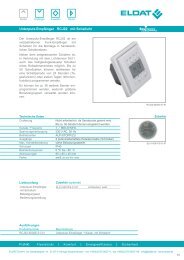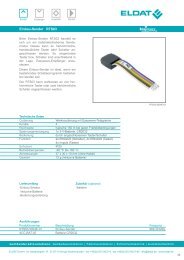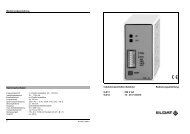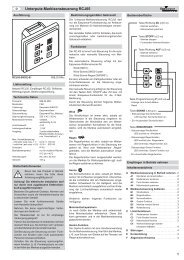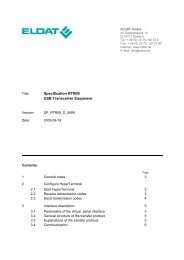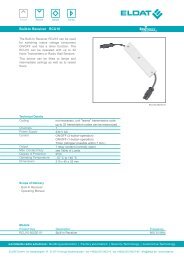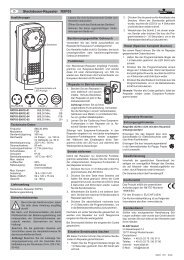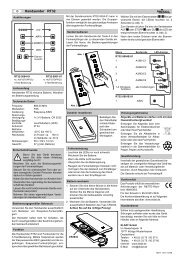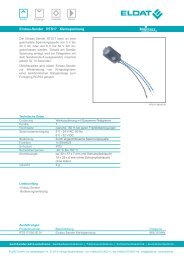Specification of RTRM08 Transceiver Module Easywave I2C - ELDAT
Specification of RTRM08 Transceiver Module Easywave I2C - ELDAT
Specification of RTRM08 Transceiver Module Easywave I2C - ELDAT
You also want an ePaper? Increase the reach of your titles
YUMPU automatically turns print PDFs into web optimized ePapers that Google loves.
<strong>Specification</strong><br />
Index 1.01<br />
Project No.<br />
RF-Products, Controller <strong>RTRM08</strong> <strong>Transceiver</strong> <strong>Module</strong> Easw I 2 C Page 21<br />
Development<br />
Production S. Schreiber 2007-08-24<br />
7007<br />
RX_STATUS register is 1. Check the RX_MODE register. If the RX_MODE register is PWD_RST, set the<br />
RX_MODE register to RX_RQ or RX_PL again, and start with the first bullet.<br />
• Read the RX_TEL_VALID-bit in the RX_STATUS register, the channel number, the button number, and the<br />
opaque user data from the RX_CHANNEL, RX_BUTTON, RX_USERDATA0, and RX_USERDATA1 registers if<br />
necessary.<br />
• Read the RX_ACK register.<br />
• Start with the first step.<br />
Note that the current implementation interrupts any receive attempts <strong>of</strong> <strong>Easywave</strong> telegrams while the<br />
RX_USERDATA0 and RX_USERDATA1 registers are written.<br />
Learning <strong>of</strong> <strong>Easywave</strong> Telegrams<br />
The RX_MODE register must be set to the LN_RQ value or the LN_PL value (Learn Mode). If the RX_MODE<br />
register is LN_PL, the / REQ output is always inactive (high). If the RX_MODE register is set to LN_RQ, the<br />
/ REQ output works as described in the next paragraphs.<br />
The Learn Mode works just as the receive mode except that the transceiver module does not modify the<br />
RX_CHANNEL register. The I 2 C master has to set this register appropriately and the transceiver module<br />
learns the first <strong>Easywave</strong> telegram which it receives after entering the Learn Mode.<br />
The transceiver module ignores any received <strong>Easywave</strong> telegram while being in Learn Mode if it is one which<br />
has been already learned before.<br />
After the transceiver module has learned an <strong>Easywave</strong> telegram, it ignores further received <strong>Easywave</strong><br />
telegrams.<br />
The transceiver module sets the appropriate bit in the bit mask <strong>of</strong> the RX_LN_CH0_7, RX_LN_CH8_15,<br />
RX_LN_CH16_23, and RX_LN_CH24_31 registers to indicate that the channel is used now. If the channel<br />
has been used before, the <strong>Easywave</strong> telegram which has been learned before will be overwritten.<br />
The green LED blinks as long as the transceiver module receives any <strong>Easywave</strong> telegram. (The LED is<br />
drawn on Figure 1 on page 4).<br />
A master should perfom the following steps if it wants to learn an <strong>Easywave</strong> telegram:<br />
• Set the RX_MODE register to the PWD or PWD_RST value. This prevents the transceiver module from<br />
modifying the RX_CHANNEL register.<br />
• Set the RX_CHANNEL register appropriately. The master can determine an unused channel by reading the<br />
bit mask from the RX_LN_CH0_7, RX_LN_CH8_15, RX_LN_CH16_23, and RX_LN_CH24_31 registers.<br />
The master also can write some user data into the RX_USERDATA0 and RX_USERDATA1 registers.<br />
• Set the RX_MODE register to the LN_RQ or LN_PL value.<br />
• Wait until the / REQ output goes low (LN_RQ only) or wait until the RX_TEL_CHANGED-bit in the<br />
RX_STATUS register is 1. Check the RX_MODE register. If the RX_MODE register is PWD_RST, start with the<br />
first bullet.<br />
• Read the RX_TEL_VALID-bit in the RX_STATUS register, the channel number, the button number from<br />
the RX_CHANNEL and RX_BUTTON registers if necessary.<br />
• Read the RX_ACK register.<br />
• If the RX_TEL_VALID-bit in the RX_STATUS register was 1 above, the transceiver module has learned an<br />
<strong>Easywave</strong> telegram. If the RX_TEL_VALID-bit in the RX_STATUS register was 0, the master should<br />
continue waiting for an <strong>Easywave</strong> telegram (fourth bullet).<br />
• The master can write some user data into the RX_USERDATA0, and RX_USERDATA1 registers again if<br />
desired.



